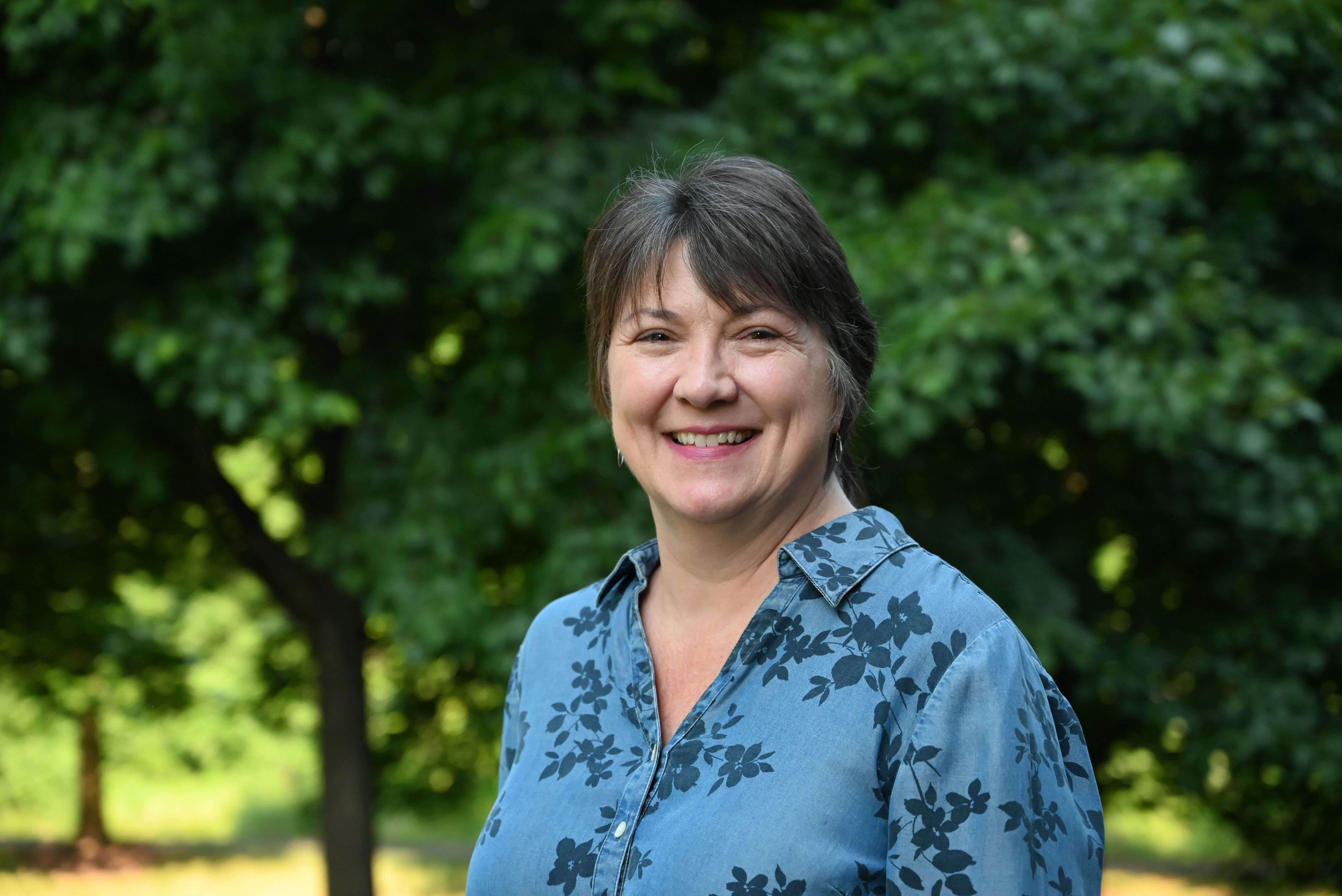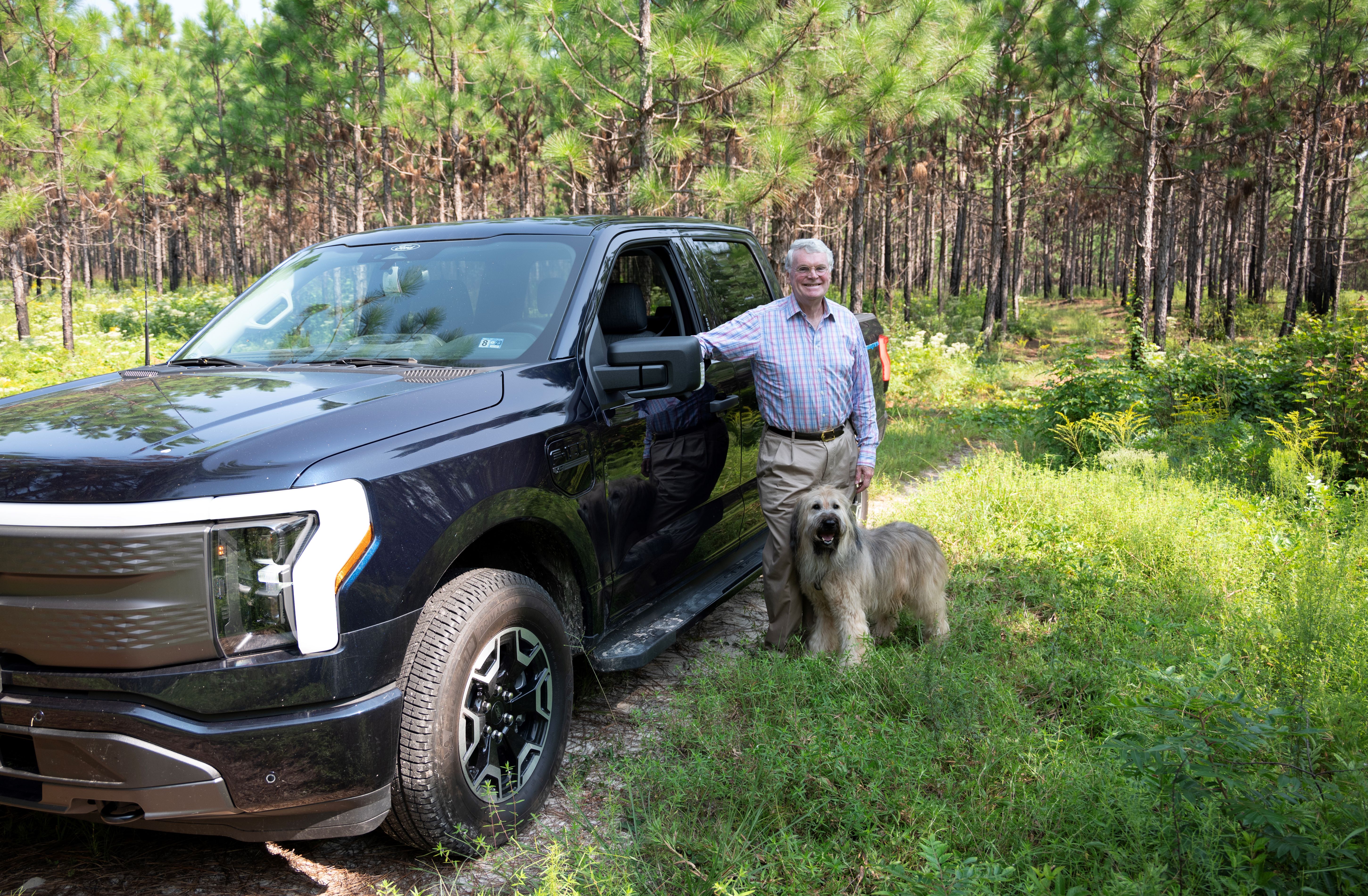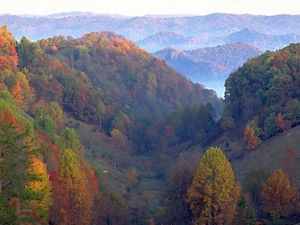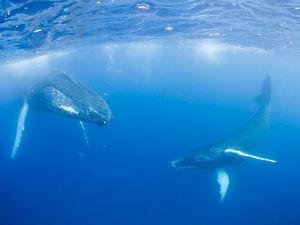Our Virginia: Impact Report 2024
From the Appalachians to our Atlantic barrier islands, we're seeing conservation pay off across Virginia.
From the Director
A Historic Collaboration
Our Virginia team recently joined with Nature Conservancy colleagues in Maryland, North Carolina and South Carolina on a proposal to bring our science and our conservation expertise to bear on the region’s climate challenges. I’m thrilled that our collaboration will continue, thanks to a historic $200 million EPA grant that will bolster the funding we need to implement nature-based climate solutions (see page 4).
With more than $47 million coming to Virginia, we look forward to working with the commonwealth, as well as our regional colleagues, to implement one of the largest-ever grants for natural climate solutions. An award of this size means several things. First, the EPA recognizes that our natural resources are vital to mitigating climate change. Moreover, the grant makes an emphatic statement that investing in nature pays off in myriad environmental, economic and community benefits.
This grant also represents a tremendous amount of trust in The Nature Conservancy—from the quality of the science that guides us to our track record of bringing people together to get things done. To that end, it gives us the flexibility to approach each project with the most appropriate tool from our conservation toolbox: land acquisition,
habitat restoration, conservation easements, carbon agreements and more.
To maximize our impact in Virginia, TNC will focus on protecting, enhancing and restoring forests and wetlands. Some of our specific goals include conserving an additional 36,000 acres of hardwood forests in the Appalachians, nearly 8,000 acres of longleaf pine ecosystem and 150 acres of tidal wetlands. In addition to capturing carbon, this work will lower wildfire and flood risks and expand opportunities for outdoor recreation.
The magnitude of the climate challenge makes public-private partnerships critical, and it’s TNC supporters like you who make them possible. Your support enables us
to follow the science, get results on the ground and earn public trust. Thank you for helping us demonstrate how conservation contributes to a healthy environment, economy and society!
Download the Report
-
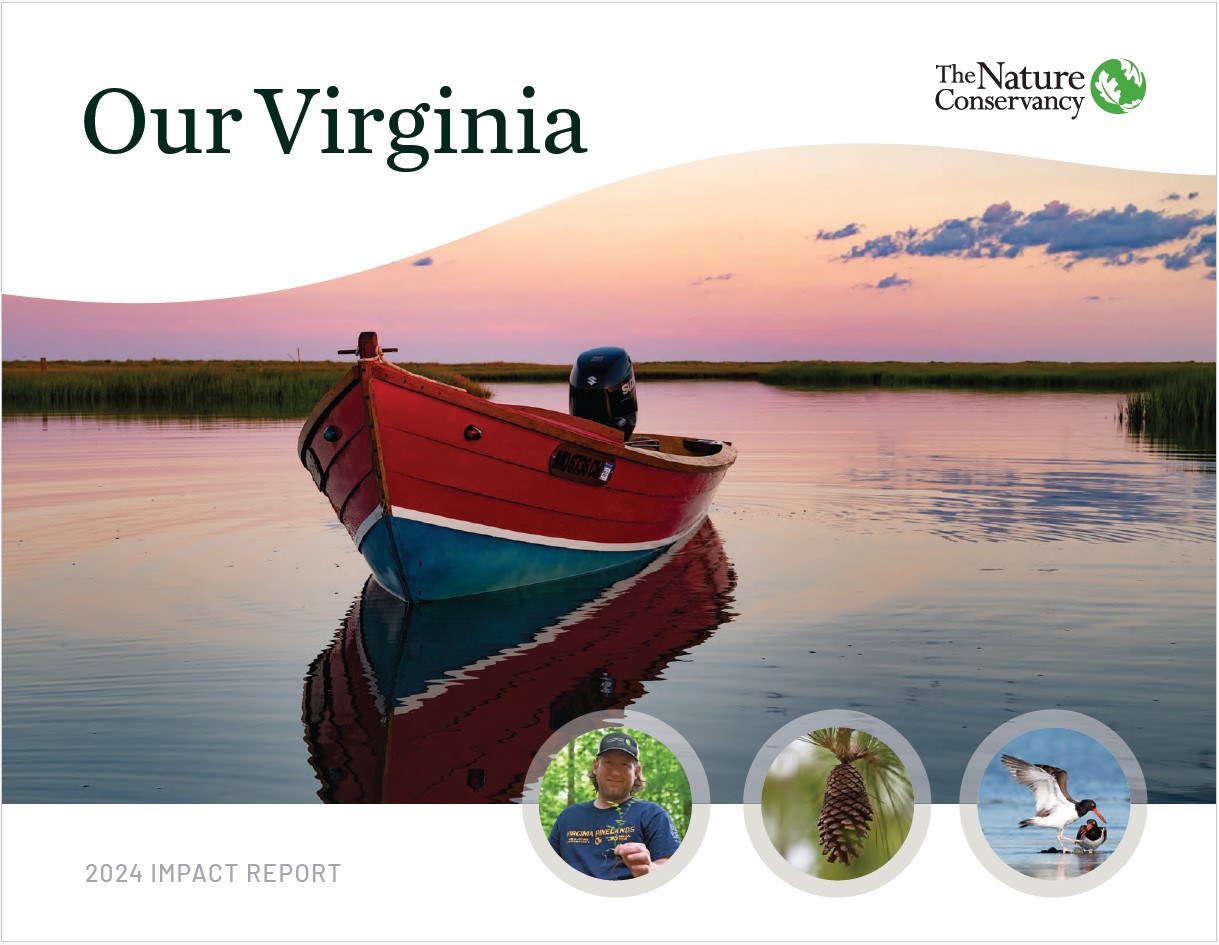
Our Virginia: 2024 Impact Report
From the Appalachians to our Atlantic barrier islands, we're seeing conservation pay off across Virginia. Take a deep dive with our 2024 Impact Report. *Spanish version at the end of this page
DOWNLOAD
Virginia to Share
A Historic Grant from EPA
In July, the Environmental Protection Agency announced one of its largest grants for nature-based climate solutions, awarding The Nature Conservancy $200 million to support our work across Virginia, Maryland, North Carolina and South Carolina. Between January 2025 and January 2030, this funding will support projects focused on improved forest management, peatland restoration and tidal wetland enhancement—three areas identified as having the highest potential reductions of greenhouse gas emissions.
For Virginia’s share, TNC will receive $47.2 million to conserve forests and improve forest management across the Appalachians and Southeast Virginia, as well as to restore tidal wetlands in Eastern Virginia, all of which will involve collaborating across state lines to maximize climate benefits.
“We are looking forward to further collaboration with the Commonwealth of Virginia and the states of North Carolina, South Carolina and Maryland to bring natural climate solutions to the challenges we are all facing,” says Bettina Ring, TNC’s Virginia state director. “At TNC, we recognize the numerous environmental, economic and community benefits our natural resources can provide if we support their resiliency and sustain them for future generations.”
Download our 2024 Impact Report to read the full story.
Conservation News
Science and Inspiration
Supporting Southwest Virginia Communities
"The awarded organizations are leading the way to create opportunities that benefit community, nature and economy in Southwest Virginia.”
— Nick Proctor, Clinch Valley Program

In June, The University of Virginia's College at Wise, The Nature Conservancy, the Cumberland Forest Limited Partnership, and the Anne and Gene Worrell Foundation announced the 2024 award recipients of the Cumberland Forest Community Fund. Now in its third year, this competitive local grant program supports nature-based economic and community development projects within our Cumberland Forest Project’s seven-county Virginia footprint.
The towns of Cleveland, Dungannon, Honaker and Richlands, along with Appalachian Sustainable Development, Breaks Interstate Park, Friends of the Buchanan County Library and Mountain Kids Inc., received a total of $100,000 for projects such as a community garden expansion, an aquatic research station and recreation area improvements.
“We are inspired by this year’s recipients,” says Nick Proctor, community outreach manager for TNC’s Clinch Valley program.
We are Investing in Future Conservation Leaders. The Nature Conservancy realizes the urgent need to foster our next generation of conservation leaders, as well as to build a stronger, more diverse workforce. Virginia’s Short Term Experience Program (STEP) launched this year with eight paid summer internships geared to college students and recent graduates.
Download our 2024 Impact Report to read all about our 2024 interns' work.
Protecting a Coastal Community
As 2024 neared its end, so did a nearly four-year restoration project just offshore from Wachapreague. Volunteers helped our Volgenau Virginia Coast Reserve team put the last oyster castle in place, completing a pilot living-shoreline project designed to strengthen a marsh island and help buffer the town’s waterfront.
“We used oyster reefs to stem erosion and fortify the island shoreline against storms,” says TNC Coastal Scientist Bo Lusk. The low-lying Eastern Shore town is susceptible to climate impacts such as rising sea levels and stronger, more frequent storms. As storms push larger waves from the Atlantic Ocean toward the mainland, marsh and barrier islands serve as natural buffers that deflect and disperse some of that energy.
The restoration site stands between the town and a broad bay whose waters have been chipping away at these protective marshes. TNC and our partners undertook this project to test different structures on which oysters can live and build, as well as to measure how effectively these evergrowing reefs can stem erosion and enable the marsh to spread.
Over the project’s course, 160 volunteers helped deploy 10,000 concrete castles, and they helped make and install 1,600 Oyster Catchers—a new design by Sandbar Oyster Company using lighter, biodegradable materials. Already, the once crumbling island shoreline is teeming with oysters.
Measuring the Benefits of Seagrass Restoration
Every spring, dozens of volunteers brave the chilly seaside waters off Virginia’s Eastern Shore to collect seeds as part of the largest, most successful seagrass restoration project in the world. TNC and partners have returned seagrass meadows to 10,000 acres of bay bottoms since the habitat nearly disappeared during the 1930s.
Our understanding of seagrass benefits has also expanded thanks to a two-year study completed this year by TNC scientist Mariana Camacho. Camacho’s conclusions will be published in a report that quantifies the myriad benefits. These include “blue carbon” storage, the long-term containment of carbon dioxide within the seagrass itself and in the soils from which it grows.
We Can’t Save Nature Without You
Sign up to receive monthly conservation news and updates from Virginia. Get a preview of Virginia's Nature News email

Conservation Leadership
Singing the Praises of Longleaf Pine and Electric Vehicles
Retired musician and Nature Conservancy trustee Bill Owen has become known across the South for singing the praises of longleaf pine. At Raccoon Creek Pinelands, his farm in Yale, Owen has worked with TNC and myriad restoration partners to plant more longleaf pine than anywhere else in Virginia.
I’ve visited before to document plantings and observe prescribed burns that enable longleaf systems to thrive. But this summer, as Owen takes me on a tour of the farm, our conversation turns from fire to Lightning—as in his Ford Lightning pickup truck.
Clean. Quiet. Fast. The words repeat like a chorus as Owen explains why he’s happy he switched to electric vehicles (EVs). In addition to the truck, which he owns and uses primarily around the farm, Owen leases an electric Mustang that he drives on longer trips.
To demonstrate the truck’s power, Owen turns onto an empty rural highway and punches the accelerator. The truck surges forward, almost silently, and I’m completely surprised by the sudden weight of gravity pressing me into the seatback.
Steering us onto a rough two-track into a grove of pines, Owen tells a story about another time the Lightning’s performance proved to be, well, shocking. “Raccoon Creek hosted Martha Williams, who was the then-new director of the U.S. Fish & Wildlife Service,” he says. “We had all of the conservation leadership in Virginia here, and I had hired a 30-person bus.” The tour was going as planned—until the bus became hopelessly stuck.
The group discussed calling for a tow truck or tractor. “Then I said, ‘You know, I’ve got this new electric truck,’” Owen continues. “Everybody’s like, ‘No way,’ but I sent somebody racing to the house to get this,” he says, pointing to the steering wheel. “It pulled that bus right out.
Not even a hiccup.” He adds, chuckling, “That was great publicity for it.” Owen acknowledges that EVs won’t meet everyone’s needs, at least until the range and charging infrastructure expand. “But the improvement that’s happened with electric cars since they first came out has been staggering,” he says, and they fit his lifestyle well. If you mostly drive within a 300-mile radius of home, he explains, then EVs have the advantage, including minimal maintenance. “There’s no oil to change, and there’s really no tune-up involved,” he says. Owen’s vehicles have seen the inside of a shop only for tire rotations and annual state inspections.
The attribute that most influenced Owen’s transition to EVs, though, is that they’re simply cleaner. And that’s where his priorities and TNC’s align. In Virginia, personal vehicles generate more greenhouse gas emissions than any other sector. According to Lena Lewis, who manages TNC’s Virginia energy and climate policy work, consumers need options to enable easier, faster transitions to EVs. “The single most effective thing most Virginians can do to lower your carbon footprint is to switch from gas-powered to electric vehicles,” Lewis says.
Download the Report
-

Our Virginia: 2024 Impact Report
From the Appalachians to our Atlantic barrier islands, we're seeing conservation pay off across Virginia. Take a deep dive with our 2024 Impact Report.
DOWNLOAD
Descargar el Informe en Español
-

Nuestra Virginia: Informe de Impacto 2024
The Nature Conservancy en Virginia está trabajando por un futuro donde las personas y la naturaleza pueden prosperar. Obtenga más información en nuestra El Informe de Impacto Anual de 2024, ahora disponible en Español.
DOWNLOAD
Looking Back
-
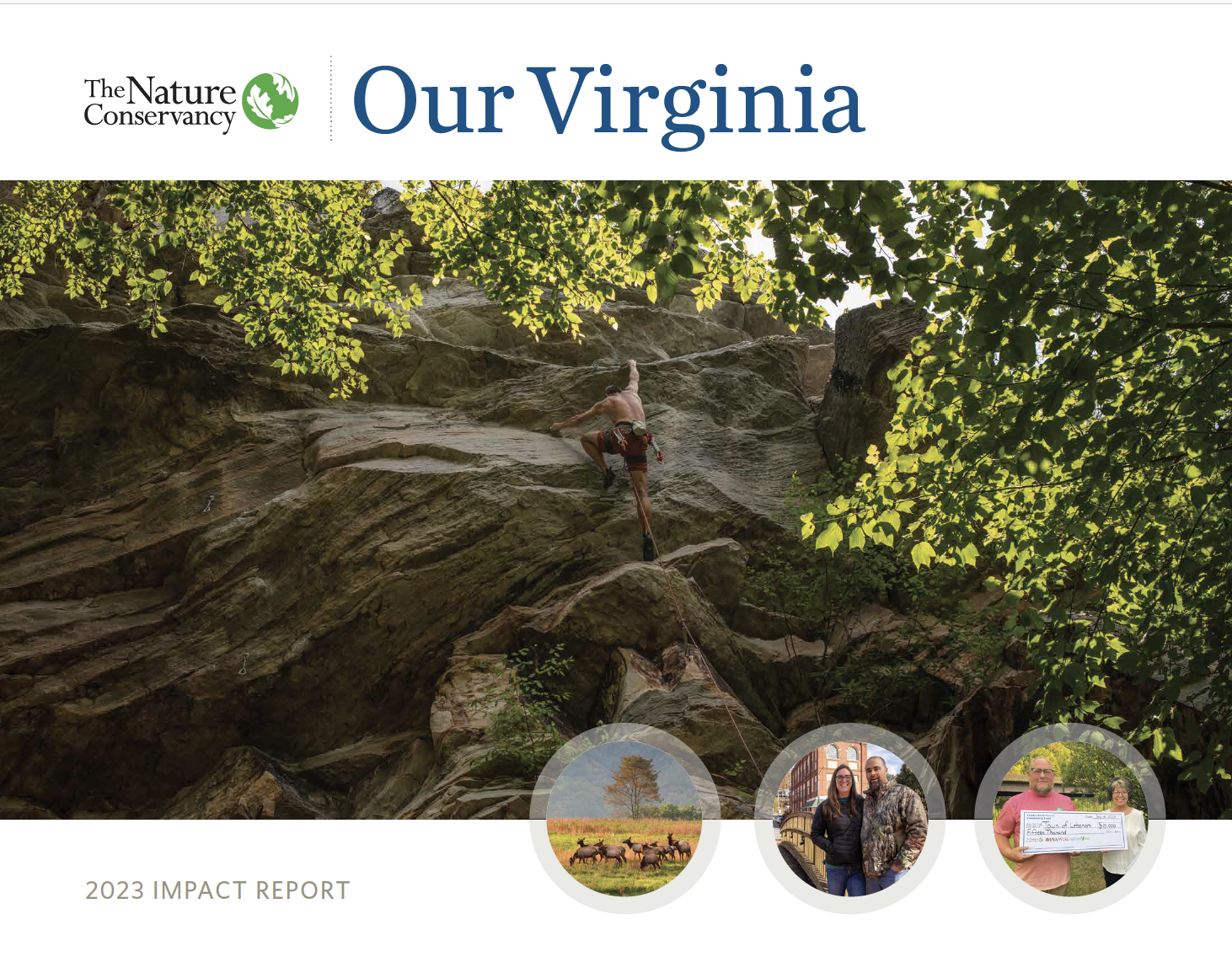
Our Virginia: 2023 Impact Report
From the Appalachians to our Atlantic barrier islands, we're seeing conservation pay off across Virginia. Take a deep dive with our 2023 Impact Report.
DOWNLOAD
Make a Difference
Together we can find creative solutions to tackle our most complex conservation challenges and build a stronger future for people and nature. Will you help us continue this work?

